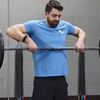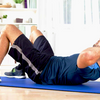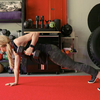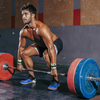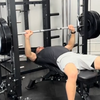Romanian Deadlift vs. Deadlift: Which One's the Real King of Leg Day?
When it comes to building strength, deadlifts are non-negotiable. They’re the cornerstone exercise that targets multiple muscle groups and elevates your overall fitness. Among the various deadlift variations, the Romanian Deadlift (RDL) and conventional deadlift stand out as top choices. Knowing the differences between these two can be the key to maximizing your training and achieving your specific fitness goals.
Conventional Deadlift
What Is a Conventional Deadlift

The conventional deadlift is a fundamental weight training exercise that’s essential for building strength and muscle across the lower body. It primarily targets the muscles in your lower back, hamstrings, glutes, and calves, making it a powerhouse move in any serious strength training routine. Recognized as one of the "big three" lifts in powerlifting—alongside the squat and bench press—the conventional deadlift is a true test of overall strength. Whether you're aiming to build muscle, improve functional fitness, or compete in powerlifting, the conventional deadlift is a key exercise that forms the backbone of a well-rounded program.
Benefits of Conventional Deadlift
It is more than just a brute strength exercise—it’s a powerhouse for overall athletic development. Here’s how the conventional deadlift benefits your body:
- Enhances Core Stability: By activating the abdominal, lower back, and glute muscles, the deadlift helps strengthen your core, which improves your ability to control your body during other exercises and daily activities, enhancing overall athletic performance.
- Improves Grip Strength: The need to firmly grip the barbell during deadlifts strengthens your forearm muscles, which enhances your grip strength, benefiting other exercises and tasks that require a strong grip.
- Engages Multiple Muscle Groups: The deadlift simultaneously activates major muscle groups like the back, legs, glutes, and core, effectively promoting overall muscle growth and increasing strength, especially in the lower back and glutes.
- Improves Functional Strength: The movement pattern of the deadlift mimics real-life lifting tasks, helping you apply your strength more effectively in everyday activities, such as lifting heavy objects more safely and easily.
- Improves Posture: By strengthening the posterior chain (including the lower back, glutes, and hamstrings), the deadlift helps correct posture issues, improving your stance and gait.
Conventional Deadlift Technique
Mastering the conventional deadlift requires precision and attention to detail. Here are some tips that advanced scholars should pay attention to
- Foot Placement: Position your feet hip-width apart, ensuring the barbell is over the midfoot to maintain proper balance and alignment throughout the lift.
- Core Engagement: Activate your core muscles to stabilize your spine and provide support during the lift, reducing the risk of lower back strain.
- Hip Hinge: Initiate the movement by hinging at the hips rather than bending at the waist, which helps maintain a neutral spine and proper lifting mechanics.
- Grip and Arm Position: Use a shoulder-width grip on the barbell, keeping your arms straight and elbows fully extended to ensure effective lifting and reduce strain on the shoulders.
- Drive Through Heels: As you lift, push through your heels to engage your posterior chain effectively and ensure that the force is directed through your legs and glutes.
- Finish Position: Conclude the lift by standing tall with your shoulders back, ensuring full hip extension and a stable, upright posture at the top of the movement. Focusing on these technique points will help you execute the conventional deadlift with precision, enhancing its effectiveness and reducing the risk of injury.
Romanian Deadlift
What Is a Romanian Deadlift

The Romanian Deadlift (RDL) is a variation of the conventional deadlift that focuses more on the posterior chain—specifically the hamstrings, glutes, and lower back. Unlike the conventional deadlift, the RDL starts from a standing position and emphasizes the eccentric, or lowering, phase of the lift. This movement is less about moving heavy weights and more about developing strength, flexibility, and muscle control in the lower body, particularly the hamstrings.
Benefits of Romanian Deadlifts
Romanian Deadlifts are highly effective for building hamstring strength, improving hip mobility, and enhancing overall posterior chain development. Here’s how Romanian Deadlifts (RDLs) provide benefits:
- Builds Hamstring Strength: RDLs specifically target the hamstrings, leading to increased strength and muscle development in this area, which is crucial for movements involving knee flexion and hip extension.
- Improves Hip Mobility: The hip hinge motion in RDLs helps enhance hip flexibility and mobility, which can improve your range of motion and overall functional movement.
- Enhances Posterior Chain Development: By focusing on the hamstrings and glutes, RDLs contribute to comprehensive development of the posterior chain, which supports overall lower body strength and stability.
- Corrects Muscle Imbalances: RDLs isolate the hamstrings and glutes more effectively than conventional deadlifts, helping to address and correct any imbalances between these muscle groups and the rest of the posterior chain.
- Reduces Injury Risk: Strengthening the hamstrings and glutes with RDLs can help protect against injuries by improving muscle balance and joint stability, particularly in the lower back and hips.
Romanian Deadlifts Technique
Mastering the Romanian Deadlift demands careful technique and control. Here’s a concise guide to ensure you perform the exercise effectively and safely:
- Foot Placement and Barbell Position: Start with your feet hip-width apart and hold the barbell in front of your thighs. This setup provides a stable base and ensures proper bar path throughout the movement.
- Hip Hinge and Back Alignment: Hinge at your hips with a slight bend in your knees, keeping your back straight and chest lifted. This maintains proper spine alignment and targets the hamstrings effectively.
- Bar Path: Lower the barbell slowly down the front of your legs, keeping it close to your body. This maximizes muscle engagement and maintains balance.
- Hip Drive: As you rise, drive your hips forward, fully engaging your glutes and hamstrings to return to the starting position.
- Finish Position: Stand tall at the top with your shoulders back and core engaged. This ensures full hip extension and stable posture.
Concentrating on these essential technique points will ensure you perform Romanian Deadlifts effectively and safely, maximizing their benefits while minimizing injury risk.

Difference Between RDLS and Deadlifts
|
Feature |
Romanian Deadlift (RDL) |
Conventional Deadlift |
|
Starting Position |
Standing with the barbell in hand |
Barbell starts on the ground |
|
Movement Pattern |
Hinge at the hips, slight knee bend, bar lowered to mid-shin |
Bend at hips and knees, extend both to lift bar from the ground |
|
Primary Target Muscles |
Hamstrings, glutes, lower back |
Hamstrings, glutes, lower back, quads, traps, grip muscles |
|
Focus |
Eccentric phase, hamstring stretch, muscle control |
Full-body strength, power, overall muscle engagement |
|
Purpose |
Hypertrophy, mobility, posterior chain development |
Maximal strength, powerlifting, foundational strength |
|
Weight Load |
Typically lighter, focusing on form and control |
Generally heavier, focusing on overall strength |
How to Do Rdls
Setup: Stand with feet hip-width apart, holding a barbell in front of your thighs with an overhand grip. Keep knees slightly bent.
Hinge: Push your hips back, keeping your back straight and chest up. Lower the barbell along your legs, feeling a stretch in your hamstrings.
Lower: Continue until you feel a significant stretch, usually when the barbell is around mid-shin level. Maintain a neutral spine.
Lift: Drive your hips forward to return to the starting position. Engage your glutes and hamstrings, keeping the barbell close to your body.
Finish: Stand tall with your hips fully extended and shoulders back. Keep the movement smooth and controlled.
How to Do the Deadlift
Setup: Stand with your feet about hip-width apart, ensuring the barbell is positioned over the middle of your feet.
Grip: Bend at the hips and knees to reach and grasp the barbell. Use a grip that feels comfortable and secure.
Lift: Engage your core, straighten your back, and push through your heels to lift the barbell. Keep the bar close to your body as you extend your hips and knees to stand fully upright.
Lower: Carefully reverse the movement by lowering the barbell back to the ground, ensuring to maintain control and proper technique throughout.
Best Tips for Romanian and Conventional Deadlifts
- Warm-Up: Begin with a thorough warm-up to prepare your muscles and joints. Incorporate dynamic stretches for your hamstrings, glutes, and lower back, along with light cardio to increase blood flow. Perform practice lifts with light weights to activate the specific muscles used in the deadlift.
- Proper Form: Maintain a neutral spine throughout the movement, whether you’re doing Romanian or conventional deadlifts. Focus on hinging at the hips rather than bending at the waist. Keep the barbell close to your body and ensure your back remains straight with your chest up. Engage your core and lats to stabilize your spine and prevent rounding.
- Appropriate Weight: Choose a weight that allows you to complete the lift with proper form. Start with a manageable weight to master the technique, then gradually increase as your strength improves. Avoid using too heavy a weight, as it can compromise your form and increase the risk of injury.

Which Deadlift Should You Choose?
When deciding between the Romanian deadlift (RDL) and the conventional deadlift, consider your fitness goals, experience level, and specific needs:
Fitness Goals:
- For Hamstring and Glute Development: If your primary focus is to target the hamstrings and glutes, the Romanian deadlift is ideal. Its emphasis on the hip hinge and controlled descent isolates these muscles effectively.
- For Overall Strength and Power: The conventional deadlift is better suited for building overall strength and power. It engages multiple muscle groups, including the lower back, glutes, hamstrings, and core, making it a staple for general strength training.
Experience Level:
- Beginners: If you’re new to deadlifting, starting with the Romanian deadlift can be beneficial. Its simplified movement and focus on hip hinge mechanics can help you master the basics of deadlifting before progressing to the conventional deadlift.
- Experienced Lifters: For those with more experience, the conventional deadlift offers a comprehensive workout, challenging your entire body and allowing you to lift heavier weights as your technique and strength improve.
Fitness Conditions and Limitations:
- Lower Back Sensitivity: If you have a history of lower back issues or sensitivity, the Romanian deadlift may be a safer choice. Its focus on the hip hinge reduces strain on the lower back compared to the conventional deadlift, which involves more full-body engagement.
- Overall Conditioning: If you’re looking for a more demanding exercise that tests your full-body strength and conditioning, the conventional deadlift provides a robust challenge, incorporating multiple muscle groups and requiring substantial core stability.
When to Choose Romanian Deadlifts
Choose RDLs when focusing on posterior chain development, improving hamstring flexibility, or reducing lower back strain.
- Focus on Hamstrings and Glutes: Choose Romanian deadlifts if your primary goal is to target and strengthen your hamstrings and glutes. The exercise emphasizes the hip hinge movement, providing a deep stretch and activation in these muscle groups.
- Improve Hip Hinge Mechanics: If you’re looking to improve your hip hinge technique, Romanian deadlifts are ideal. They help develop proper hinge mechanics, which can be beneficial for other lifts and functional movements.
- Lower Back Sensitivity: Opt for Romanian deadlifts if you have a history of lower back issues. This exercise places less strain on the lower back compared to conventional deadlifts, focusing more on the posterior chain while maintaining a safer load on your spine.
When to Choose Conventional Deadlifts
- Improve Lifting Performance: If you aim to enhance your performance in other lifts or sports that require explosive strength and power, conventional deadlifts are effective. They help increase your total body strength and improve functional movement.
- Train with Heavier Weights: Opt for conventional deadlifts when you want to lift heavier weights and push your limits. This exercise is well-suited for building maximal strength and developing your ability to handle substantial loads.
- Enhance Core Stability: Use conventional deadlifts to improve core stability and strength. The lift demands significant core engagement to maintain proper form, helping to build a strong, stable core.
Conclusion
Choosing between Romanian and conventional deadlifts comes down to your fitness goals and what you’re looking to achieve. If you're aiming to build strong hamstrings and glutes or improve your hip hinge technique, Romanian deadlifts are your go-to. But if you want to boost overall strength, power, and core stability, the conventional deadlift is perfect. No matter which deadlift you choose, proper form and technique are essential for maximizing benefits and minimizing injury risk. At RitKeep Fitness, we're here to support your fitness journey with top-quality equipment that helps you reach your goals. Keep lifting and stay strong!

Frequently Asked Questions (FAQ)
Are RDLs a good replacement for deadlifts?
Romanian Deadlifts (RDLs) are great for isolating and strengthening the hamstrings and glutes. However, they can’t fully replace conventional deadlifts, which are crucial for overall strength and power due to their engagement of multiple muscle groups and ability to handle heavier weights. Incorporating both into your routine can provide a well-rounded approach to strength training.
Is Romanian deadlift better than deadlift for lower back?
Romanian deadlifts (RDLs) are generally better for the lower back compared to conventional deadlifts. RDLs focus on the hip hinge movement, which places less strain on the lower back while effectively targeting the hamstrings and glutes. This can be beneficial for those with lower back sensitivity or who want to minimize lower back stress.
How heavy should RDL be compared to deadlift?
Romanian deadlifts are usually performed with lighter weights compared to conventional deadlifts. Typically, you might use about 50-70% of your conventional deadlift weight for RDLs, as they focus more on hamstring and glute activation rather than full-body strength.
Should I do Romanian deadlifts slow or fast?
Romanian deadlifts should be performed slowly and with control. Focusing on a slow, deliberate movement helps ensure proper form, emphasizes the stretch and contraction of the hamstrings and glutes, and reduces the risk of injury.
Is RDL really effective?
Yes, Romanian deadlifts (RDLs) are highly effective. They specifically target the hamstrings, glutes, and lower back, improving strength and muscle definition in these areas. RDLs also enhance hip hinge mechanics and can aid in reducing lower back strain, making them a valuable addition to any strength training routine.
Is RDL for strength or hypertrophy?
Romanian deadlifts (RDLs) can be effective for both strength and hypertrophy. They primarily target the hamstrings and glutes, making them great for muscle growth (hypertrophy) due to the emphasis on controlled, full-range movements.
